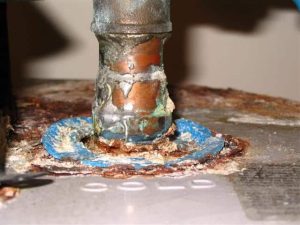Toronto plumbers work hard to ensure good health for citizens by offering a wide range of services that aim to improve the health of our drinking water. One such plumbing service involves testing for lead in pipes, which poses a significant health risk, in particular to fetuses, infants and young children. Often found in nature, lead, at minute exposure levels can lead to minor biochemical changes, but it can have toxic and severe neurological effects. At high levels, due to vulnerability, increased absorption, or due to frequent exposure to lead, it may lead to death.
By eliminating lead in water, particularly in your household potable supply, you can reduce these risks for yourself and for your family. While the younger generation is at a higher risk to develop learning disabilities and physical and cognitive development delays, adults who consume water that contains lead are at increased risk of developing high blood pressure and kidney disease later in their lives.
Toronto Plumber Explains How Lead Gets Into Water

Until the mid-80s, plumbing systems generally consisted of lead pipes, and lead fixtures. Even today, many plumbing systems contain chrome-plated brass, which is a major culprit in leaching lead into your water supply. Mostly very old, or brand new homes are affected by lead in water. The hot water supply is more likely to be tainted by lead contamination.
Water that sits in pipes for extended periods of time are more likely to contain substantially higher levels of lead.
Corrosion takes place usually as the result of low mineral content, low pH, or dissolved oxygen in the water.
You may have lead in your pipes if your plumbing system has lead pipes, or if there is corrosion in your plumbing system. Stained dishes or laundry, brown water and frequent water leaks are some of the signs that you may have corrosion, or even lead in pipes. Testing for lead in water is inexpensive and accurate, and can establish whether the service connector consists of lead.
What Can Be Done About Lead in Water?

Never consume water from the hot water faucet for drinking or cooking.
If you live in an apartment where flushing is less effective, or in a home with lead piping, it is important to contact a family plumber who can test your water supply for lead in pipes. Should the test come back positive for lead in your pipes, various options can be discussed to improve the health of your family's drinking water. From faucet-based water filters to reverse osmosis systems that purify your home's entire water supply, there are many ways to reduce lead in water. Also be sure to ask your Toronto plumber to replace any metal pipes with modern piping that will not leach lead into your water supply.
